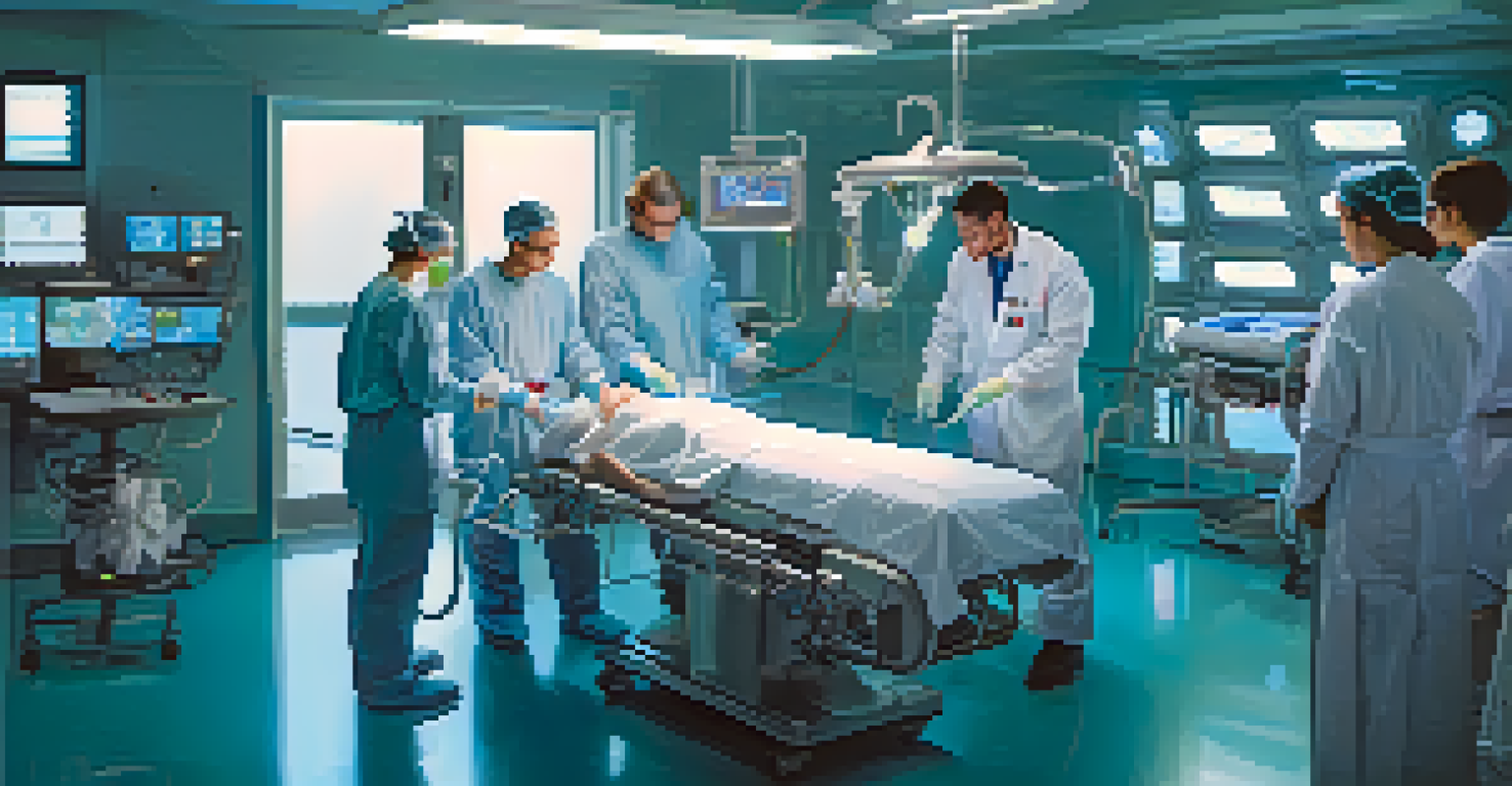Tissue Engineering: Building New Organs for Patients' Needs

Understanding Tissue Engineering and Its Purpose
Tissue engineering is a cutting-edge field that combines biology and engineering to create new tissues and organs. This innovative approach aims to replace or repair damaged tissues in the body, enhancing the quality of life for patients with various medical conditions. By harnessing the body’s natural healing processes, tissue engineering offers a promising alternative to traditional organ transplants.
The future belongs to those who believe in the beauty of their dreams.
Imagine a world where a damaged heart or liver could be replaced with a lab-grown organ that functions just like the original. This concept is not just a dream; it's becoming a reality as researchers develop techniques to cultivate tissues in controlled environments. With advances in stem cell research and 3D printing, the possibilities for building organs tailored to individual patient needs are expanding rapidly.
The ultimate goal of tissue engineering is to provide personalized medical solutions, reducing the reliance on donor organs, which are in limited supply. Each patient's unique biological makeup can be taken into account, potentially leading to better acceptance by the body and improved outcomes. This approach opens up a new realm of possibilities in regenerative medicine.
The Role of Stem Cells in Tissue Engineering
Stem cells are often referred to as the body's raw materials, having the unique ability to develop into different cell types. In tissue engineering, these versatile cells are crucial as they can be guided to form specific tissues, whether it’s skin, cartilage, or even organs. Researchers are particularly interested in embryonic stem cells and induced pluripotent stem cells for their potential to produce various specialized cells.

For example, scientists can take skin cells from a patient and reprogram them into stem cells that can then be transformed into heart cells. This technology not only creates a supply of cells tailored to the patient but also minimizes the risk of rejection, a common issue with traditional transplants. By using a person’s own cells, the chances of the body accepting the new tissue significantly increase.
Tissue Engineering Revolutionizes Medicine
This innovative field combines biology and engineering to create lab-grown tissues and organs, offering alternatives to traditional transplants.
The versatility of stem cells is a game-changer for tissue engineering, allowing researchers to explore innovative solutions for complex medical challenges. As our understanding of stem cell biology improves, the potential for creating functional tissues and organs grows, making it an exciting area of study in medical science.
3D Bioprinting: A Revolutionary Tool in Organ Creation
3D bioprinting is transforming the way we approach tissue engineering by allowing scientists to layer living cells into complex structures. This technology mimics the natural arrangement of tissues and organs, providing a scaffold for cells to grow and thrive. Imagine a printer that uses bio-ink made from cells to create a heart or liver; this is the future of organ creation.
Science knows no country, because knowledge belongs to humanity, and is the torch which illuminates the world.
The precision of 3D printing enables researchers to design organs with intricate patterns and functions that closely resemble those found in the human body. By customizing each layer, they can ensure that the final product meets the specific needs of each patient. This method not only increases the efficiency of organ production but also enhances the functionality of the engineered tissues.
As 3D bioprinting continues to advance, we may see a future where organ shortages become a thing of the past. This technology holds the promise of creating fully functional organs on demand, drastically changing the landscape of organ transplantation and regenerative medicine.
Challenges Facing Tissue Engineering Today
Despite the exciting advancements in tissue engineering, several challenges remain that researchers must overcome. One significant hurdle is the complexity of replicating the intricate structures and functions of human organs. Each organ has a unique architecture and cellular environment, making it difficult to create a perfect replica in the lab.
Additionally, ensuring the longevity and functionality of engineered tissues once implanted into a patient is a critical concern. The engineered tissues must integrate with the body’s existing systems, which can be a complex process. Researchers are constantly exploring ways to optimize the properties of bio-materials and cell types to enhance the success rates of these procedures.
Stem Cells: Key to Personalized Solutions
Stem cells serve as versatile building blocks in tissue engineering, enabling the development of patient-specific tissues and reducing rejection risks.
Funding and regulatory hurdles also pose challenges to the advancement of tissue engineering. As this field grows, securing financial support for research and navigating the approval processes for new therapies remain essential steps toward bringing these innovations to the clinic.
The Impact of Tissue Engineering on Transplantation
Tissue engineering is poised to revolutionize the field of organ transplantation by providing alternatives to traditional donor organs. By creating organs in the lab, we can address the critical shortage of available organs, which affects countless patients waiting for transplants. This innovation could ultimately save lives and reduce the burden on healthcare systems worldwide.
Moreover, lab-grown organs could significantly lower the risk of transplant rejection since they can be made using the patient’s own cells. This personalized approach would not only improve the success rates of transplants but also enhance the overall health and recovery of patients. Imagine a future where waiting lists for organ transplants become obsolete, thanks to tissue engineering.
As the technology continues to evolve, the potential for engineered organs to replace and restore function to damaged tissues creates hope for patients with chronic illnesses. The synergy between tissue engineering and transplantation is a promising avenue that could reshape the future of medical treatments.
Ethical Considerations in Tissue Engineering
As with any groundbreaking technology, tissue engineering raises important ethical questions that need careful consideration. Issues related to the sourcing of stem cells, particularly from embryos, spark debates about the moral implications and potential regulations surrounding their use. Balancing scientific advancement with ethical responsibility is essential to gaining public trust in these innovations.
Additionally, the concept of creating organs raises questions about 'designer' organs and the potential for inequality in access to these technologies. If certain patients can afford personalized, lab-grown organs while others cannot, it could lead to disparities in healthcare. Ensuring equitable access to these advancements is a critical challenge that society must address.
3D Bioprinting Transforms Organ Creation
3D bioprinting allows for the precise layering of living cells, paving the way for customized organs that mimic the complexity of human anatomy.
Ongoing discussions among scientists, ethicists, and policymakers are crucial to navigate these complex issues. Establishing clear guidelines and regulations will help ensure that tissue engineering develops in a way that is ethical, inclusive, and beneficial for all patients.
The Future of Tissue Engineering: What Lies Ahead?
The future of tissue engineering is bright, with numerous exciting developments on the horizon. As technology continues to advance, we can expect more sophisticated methods for creating functional tissues and organs. This progress holds the potential to change the landscape of medicine, providing new treatments for conditions that currently have limited options.
Researchers are also exploring the integration of artificial intelligence (AI) and machine learning to enhance the design and production of engineered tissues. These tools could streamline the process, improve precision, and reduce the time required to create complex structures. The combination of AI with tissue engineering may lead to breakthroughs we can only imagine today.

Ultimately, the goal of tissue engineering is to create a healthier future, where patients can receive personalized solutions for their medical needs. As we continue to explore the possibilities of this field, we move closer to a world where engineered tissues and organs are an integral part of patient care, fulfilling the promise of regenerative medicine.